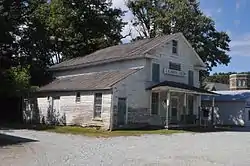Cedar Grove Rural Crossroads Historic District
Cedar Grove Rural Crossroads Historic District is a national historic district located at Cedar Grove, Orange County, North Carolina. The district encompasses 44 contributing buildings, 9 contributing sites, and 7 contributing structures in the rural crossroads community of Cedar Grove. The district developed from the mid-19th to mid-20th century, and includes notable examples of Late Victorian and Colonial Revival style architecture. Notable buildings include the Rogers-McDade House, Eno Presbyterian Church (1897-1899), Cedar Grove Methodist Church (1939), Allison-Oliver-Pender Store (1880s), and Allen A. Ellis Store (1923).[2]
Cedar Grove Rural Crossroads Historic District | |
 Allison-Oliver-Pender Store (1880s), March 2007 | |
  | |
| Location | Roughly along Carr Store Rd. and Efland-Cedar Grove Rd., Cedar Grove, North Carolina |
|---|---|
| Coordinates | 36°10′12″N 79°10′11″W |
| Area | 125 acres (51 ha) |
| Built | c. 1880 |
| Architect | Liner, Henry; McDade, Charlie |
| Architectural style | Mid 19th Century Revival, Late Victorian, Late 19th And 20th Century Revivals |
| NRHP reference No. | 98000389[1] |
| Added to NRHP | April 23, 1998 |
It was listed on the National Register of Historic Places in 1998.[1]
References
- "National Register Information System". National Register of Historic Places. National Park Service. July 9, 2010.
- Kaye Graybeal (December 1997). "Cedar Grove Rural Crossroads Historic District" (pdf). National Register of Historic Places - Nomination and Inventory. North Carolina State Historic Preservation Office. Retrieved 2015-02-01.
| Wikimedia Commons has media related to Cedar Grove Rural Crossroads Historic District. |
This article is issued from Wikipedia. The text is licensed under Creative Commons - Attribution - Sharealike. Additional terms may apply for the media files.

